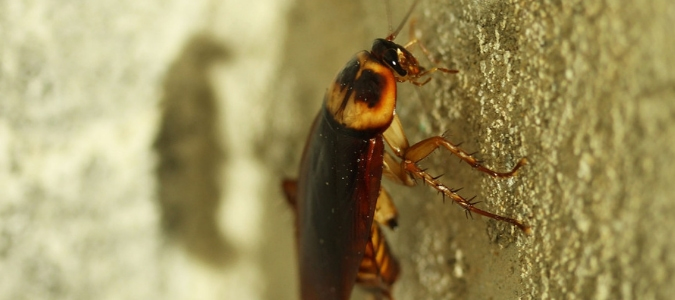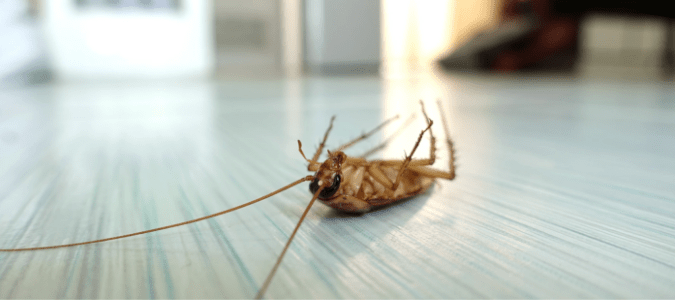What causes cockroaches? This is a good question to ask whether you have a cockroach problem in your home or not. Cockroaches are frightening and disgusting to most. Worse yet, they can actually transmit serious illnesses to people. Knowing what causes cockroaches will help you avoid attracting these pests into your living space.
The bad news is, there are lots of things that can attract cockroaches into your home. Many of us leave pet food out in bowls, or dirty dishes in the sink. We also don’t always wipe down the stovetop and kitchen counters as soon as we should. Unfortunately, these common and seemingly innocent behaviors can actually draw cockroaches. Keeping up with housecleaning, especially in the kitchen, goes a long way toward combating roaches. Still, even the cleanest houses can have major roach problems. Let’s learn more about these pests to find out how to keep them away from your home.
The first thing to know about cockroaches is that there are several different types of roaches that people find in their homes. Spotting certain types of cockroaches, such as large black, reddish-brown or dark brown roaches, may or may not mean you have an actual infestation. Spotting small German cockroaches in your home, on the other hand, is often a sure sign of an infestation.
German roaches often come into people’s homes as stealthy hitchhikers hidden in cardboard boxes, grocery bags, furniture or luggage. Small roach egg cases are also easy to unknowingly bring home with you. German cockroaches are known for reproducing very quickly. A single female German cockroach can lay hundreds of eggs in her lifetime. This is yet another reason this type of roach can so easily infest people’s homes, and can be tough to get rid of once they’ve settled in.
Larger cockroaches like American and Oriental cockroaches normally make their nests outdoors, in mulch, dead leaves and underbrush, or in old logs or tree trunks. When the weather or the season makes it tough to find food and water outside, such as during long weeks of summer heat, these roaches might venture indoors to find the water and food they need to survive. Plenty of times, they actually come inside by accident by exploring and finding their way through an opening. They also might come inside by following plumbing pipes into your home.
This is why it’s so important to fix broken screens on your windows and exterior doors, replace worn out weatherstripping on thresholds and plug up weep holes and gaps around vents or hose bibs with steel wool. American cockroaches may be enormous—they can grow to over a half-inch wide and almost two inches long. But, they’re pretty flat and can fit through tiny openings. Basic home maintenance including fixing any gaps and spaces leading into your house will go a long way toward preventative pest control.
Keeping up with yard work can also help keep cockroach populations down. Clear away dead leaves and underbrush, and don’t leave empty pots lying around in your yard. These can all be attractive places for certain types of cockroaches to build nests and breed. Fewer roaches outdoors means fewer indoors.
It’s also smart to fix leaky faucets or pipes in and around your home. Dripping or standing water provides cockroaches and other pests with a good source of drinking water. Indoor potted plants can also be a great source of both water and shelter for cockroaches. Take care not to overwater your plants and trim away any dead or overgrown parts so roaches can’t easily hide in them.
Cockroaches are true survivors; there’s a reason they have been around so long. For one thing, they can and will eat almost anything. This includes non-food items they might find in your house like paper, cardboard and the glue that binds books together. They especially love grease, like the kind they can find on your stove after you cook a meal.
To cut off every possible food supply that cockroaches might try to access inside your home, store pantry food in air-tight containers; put away pet food and water bowls overnight, when cockroaches are most active; and wipe down your kitchen sink, counters and stovetop daily. Don’t let compost, trash or recycling bins sit open or inside for long. Take them outside, well away from the home, since these also attract roaches.
It’s true that most cockroach infestations in people’s homes involve German roaches and that American cockroaches often make their way into people’s homes by accident. Still, any type of cockroach, including American cockroaches, can infest your home if they find a reliable source of food and water inside as well as a good, hidden spot to build a nest.
If you spot cockroaches inside your house on a regular basis, it’s time to contact a pest control professional. A professional can conduct a thorough investigation of your home to determine the extent of your roach problem. A pro can also locate places where roaches might be getting into your house, where they’re likely nesting and what they’re feeding on inside. They can schedule regular treatments to control these pests.
Now we’ve learned a lot about what causes cockroaches. The next question to ask is, what keeps cockroaches away?
What Keeps Cockroaches Away?
Cockroaches are hardy and adaptable creatures, which makes them hard to get rid of once they’ve started reproducing indoors. Fortunately, there are many things people can do to get rid of roaches, or at least to aid in the fight against these pests:
- Keep your house clean, paying special attention to the kitchen. Spills, crumbs and grease splatters in the kitchen will all attract roaches, not to mention other types of pests. Cleaning your kitchen stove and counters daily and storing food properly will go a long way in the fight against roaches.
- Any trash, recycling and compost bins, including those used indoors as well as those kept outdoors, should have tightly fitting lids. This will help keep cockroaches and other critters out.
- Make sure your bathroom and utility room are in good working order, since cockroaches can sometimes come into the home through drains, and they’re attracted to any water they can access in these areas. Fix leaking faucets or pipes so you aren’t providing roaches and other pests with a ready water source.
- If you have pets, don’t leave their food and water bowls sitting out overnight. Cockroaches tend to be most active at night, venturing out for food and water under the cover of darkness, and they are drawn to pet bowls.
- Fix any rips or gaps in window screens and around doors, vents, hose bibs, pipes and light fixtures. These are also common spaces that cockroaches can use to come inside.
- If your home has a brick exterior, plug weep holes with steel wool to keep pests out.
- Outdoors, rake up dead leaves, clear away fallen branches and other brush, and don’t let standing water accumulate after a rain. These can all be places where roaches nest and breed.
- Sign up for ongoing pest control. Regularly scheduled inspections and treatments administered by a professional can be the most effective way to keep roaches away so you can feel peace of mind inside your home.
I Am Finding Dead Roaches: Is My Problem Going Away?
Finding dead roaches in your kitchen, bathroom or other areas of your home is almost as shocking as finding live roaches. If you find a dead roach in your home, it could be a sign that your efforts to eliminate roaches are working. But, unfortunately, it doesn’t always mean the cockroach population is getting smaller. Sometimes, finding dead roaches is a sign of an ongoing infestation.
If you do have a roach infestation in your home, there will be other signs as well. You might spot live roaches, especially if you go into your kitchen at night and turn on the light. Roaches are most active in darkness, and they’ll scatter when the overhead light comes on. You might also see cockroach droppings—tiny, dark-brown or black smears and specks on walls, counters and other areas.
Finding egg cases is another sign of a cockroach infestation, since it means there are female roaches nearby, actively breeding. Cockroach egg cases, also called oothecae, are small, brown or black in color, with smooth or banded surfaces. They look something like brown Tic-Tacs. A cockroach ootheca can hold up to 50 eggs!
Roaches also give off a distinctive, musty smell that is hard to describe. But, once you know what you’re smelling, you won’t mistake it for anything else. If you can smell a cockroach scent in a certain room or area of your house, it’s a strong sign of an extensive roach infestation that needs to be treated by a pest control specialist.
Trying to treat a roach infestation on your own often leads to extending the problem, especially in the case of a major, ongoing infestation. The roach killer products most people find at the store, such as insecticide sprays and baits, may not work well or fast enough. They might only target adult roaches, for example, leaving cockroach eggs to hatch and continue the infestation.
A pest professional knows how and where to apply effective products and treatments to control cockroaches. They can also set up a schedule for ongoing treatments and inspections to help prevent an infestation in the future.
ABC Can Create a Custom Roach Treatment Plan for Your Home
Dealing with a cockroach infestation can be disheartening and worrisome. Don’t let these pests take over your life anymore. The professionals at ABC Home & Commercial Services can create a custom roach control plan, so you can feel more comfortable in your own home.


